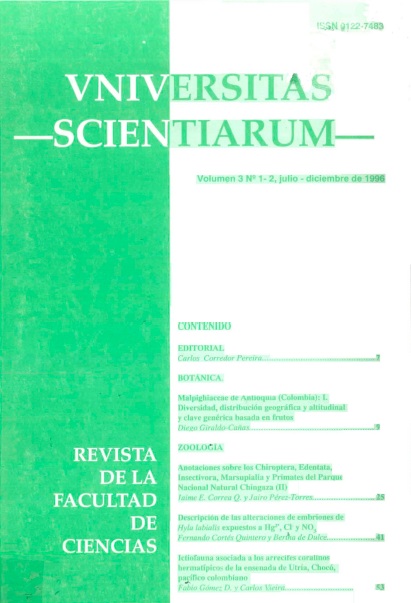Abstract
En Antioquia (Colombia), las Malpighiaceae están representadas por 75 especies distribuidas en 15 géneros, de los cuales Stigmaphyllon es el más diverso (15 spp.) seguido por Bumchosia (10 spp.), Byrsonim (9 spp.) y Banisteriopsis e Hiraea (con 8 spp. cada uno). Sólo se registraron dos especies endémicas Hiraea ramoni-ólivae Giralda-Cañas y Stigmaphyllon stenophyllum C.Anderson. El 45% de las especies registradas para Antioquia (34 spp.) están restringidas a los Andes, Chocó biogeográfico y Centroamérica y un 28% de las especies (21 spp.) están ampliamente distribuidas en el Neotrópico. Sólo tres especies presentan una distribución disyunta (Dicella julianii (Macbr.) W. R. Anderson, Ectopopterys soejartoi W. R. Anderson y Pterandra ultramontan Riley ex Cuatr.), mientras que Stigmaphyllon bamzisterioides (L.) C.Anderson es una especie que ocurre en los dos hemisferios. Además, se aportan datos sobre la distribución altitudinal de las especies, se hacen comparaciones de la diversidad y endemismo de la familia con otras siete áreas neotropicales, así como también son presentadas las afinidades florísticas entre las áreas consideradas. Por último, se presenta una clave genérica basada en los caracteres de los frutos.Univ. Sci. is registered under a Creative Commons Attribution 4.0 International Public License. Thus, this work may be reproduced, distributed, and publicly shared in digital format, as long as the names of the authors and Pontificia Universidad Javeriana are acknowledged. Others are allowed to quote, adapt, transform, auto-archive, republish, and create based on this material, for any purpose (even commercial ones), provided the authorship is duly acknowledged, a link to the original work is provided, and it is specified if changes have been made. Pontificia Universidad Javeriana does not hold the rights of published works and the authors are solely responsible for the contents of their works; they keep the moral, intellectual, privacy, and publicity rights. Approving the intervention of the work (review, copy-editing, translation, layout) and the following outreach, are granted through an use license and not through an assignment of rights. This means the journal and Pontificia Universidad Javeriana cannot be held responsible for any ethical malpractice by the authors. As a consequence of the protection granted by the use license, the journal is not required to publish recantations or modify information already published, unless the errata stems from the editorial management process. Publishing contents in this journal does not generate royalties for contributors.



